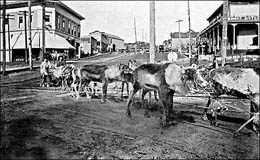On March 7, 1898, more than 500 reindeer arrive at Woodland Park in Seattle for a layover on their journey from Norway to Alaska and Canada's Yukon River. The U.S. Army Reindeer Service conceived of using reindeer to haul provisions after hearing reports of starving gold seekers in the Yukon. Large game animals are scarce due to increased hunting pressure from gold seekers and from the Inuit, who hunt more land animals as the whaling ships off the coast have decimated sea mammal populations. The reindeer can haul more weight for longer distances than sled dogs.
The Saami and their Reindeer
The miners' situation improved before the reindeer even left New York, but the herd continued on its way to be used for other projects. Among them was the United States Bureau of Education's efforts to teach the Inuit how to herd reindeer as an alternative to their hunting and gathering lifestyle. Reindeer are excellent draft animals and a source of meat.
To help manage the herd en route and then teach the Inuit how to herd, 113 Scandinavians, primarily Saami reindeer herders, accompanied the animals. (The Saami are a distinct ethnic group that occupies much of the Artic north of Finland, Sweden, and Norway. They have historically relied on reindeer, which they herd, for subsistence.) A number of the Saami were from Kautekeino, Norway. These men, some with their families, had a Saami connection to Poulsbo named John Tornensis. He had immigrated in 1893 with a separate herd of reindeer and had settled in Poulsbo in 1901. Tornensis and Johan Ulrick Xavier, the president of Pacific Lutheran College and also a Saami, encouraged the herders to settle in Poulsbo. Several of the families returned to Poulsbo after completing their work in Alaska. Many of the single Saami men married Inuit women and their descendants still live in Alaska.
The Reindeer Suffer
The herd suffered tremendous losses while on its journey. At Woodland Park an employee in charge of the animals threw out the reindeer moss that had been sent with them. He thought it was packing material. Thirteen animals died shortly after the change in their diet to grass forage. (Woodland Park at the time was privately owned. It included a small menagerie which later became the foundation for today's Woodland Park Zoo.)
After arriving in Alaska, the herders decided to move the animals up the Chilkat River to where they could find reindeer moss. Only 185 animals made it to the moss. Since the herd consisted of gelded males, they were intended for use as draft animals for the sleds and then for food. Some were used that way, others found their way into herds.
The reindeer industry in Alaska went on to have a complicated history of public and private ownership, overstocking, and the involvement of the Bureau of Indian Affairs. The reindeer themselves flourished, reaching a population of 640,000 in the 1930s. Alaskans continue to herd reindeer today, although there are only about 25,000 in herds now.

